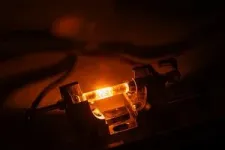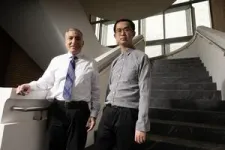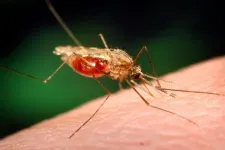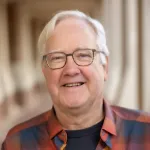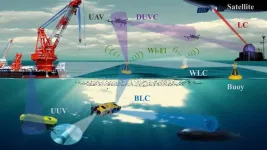(Press-News.org) HOUSTON – (Feb. 29, 2024) – Glass fiber-reinforced plastic (GFRP), a strong and durable composite material, is widely used in everything from aircraft parts to windmill blades. Yet the very qualities that make it robust enough to be used in so many different applications make it difficult to dispose of ⎯ consequently, most GFRP waste is buried in a landfill once it reaches its end of life.
According to a study published in Nature Sustainability, Rice University researchers and collaborators have developed a new, energy-efficient upcycling method to transform glass fiber-reinforced plastic (GFRP) into silicon carbide, widely used in semiconductors, sandpaper and other products.
“GFRP is used to make very large things, and for the most part, we end up burying the wing structures of airplanes or windmill blades from a wind turbine whole in a landfill,” said James Tour, the T.T. and W.F. Chao Professor and professor of chemistry and of materials science and nanoengineering. “Disposing of GFRP this way is just unsustainable. And until now there has been no good way to recycle it.”
With increased pressure from regulatory agencies to revise and improve recycling practices for end-of-life vehicles, there is a strong need for better methods to manage GFRP waste. While some have tried to develop approaches using incineration or solvolysis to get rid of GFRP, Yi Cheng, a postdoctoral research associate and Rice Academy Junior Fellow who works in the Tour lab, said such processes are less than ideal because they are resource-intensive and result in environmental contamination.
“This material has plastic on the surface of glass fiber, and incinerating the plastic can generate a lot of toxic gases,” Cheng said. “Trying to dissolve GFRP is also problematic as it can generate a lot of acid or base waste from the solvents. We wanted to find a more environmentally friendly way to deal with this material.”
Tour’s lab has already made headlines for developing new waste disposal and recycling applications using flash Joule heating, a technique that passes a current through a moderately resistive material to quickly heat it to exceptionally high temperatures and transform it into other substances. Tour said when he learned of the issues involved with GFRP disposal from colleagues at the Defense Advanced Research Projects Agency, he thought that this kind of turbo-heating could transform GFRP into silicon carbide, widely used in semiconductors and sandpaper.
“We already knew that if we heat the mixture of metal chloride and carbon by flash Joule heating, we could get metal carbide ⎯ and in one demonstration, we made silicon carbide,” Tour said. “So we were able to leverage that work to come up with a process to transform GFRP into silicon carbide.”
This new process grinds up GFRP into a mixture of plastic and carbon and involves adding more carbon, when necessary, to make the mixture conductive. The researchers then apply high voltage to it using two electrodes, bringing its temperature up to 1,600-2,900 degrees Celsius (2,912-5,252 Fahrenheit).
“That high temperature facilitates the transformation of the plastic and carbon to silicon carbide,” Tour explained. “We can make two different kinds of silicon carbide, which can be used for different applications. In fact, one of these types of silicon carbide shows superior capacity and rate performance as battery anode material.”
While this initial study was a proof-of-concept test on a bench scale in the laboratory, Tour and colleagues are already working with outside companies to scale up the process for wider use. The operating costs to upcycle GFRP are less than $0.05 per kilogram, much cheaper than incineration or solvolysis ⎯ and more environmentally friendly.
It will take time ⎯ and some good engineering ⎯ to appropriately scale up this new flash upcycling method, Tour said. He said he is thrilled that his lab was able to develop a sustainable way to transform GFRP trash into silicon carbide treasure.
“This GFRP is a waste product which usually ends up in a landfill, and now you can turn it into a usable product that can help humankind,” he said. “This is exactly the kind of approach we need to support a circular economy. We need to find ways to take waste products from a wide variety of different applications and turn them into new products.”
The research was supported by the Air Force Office of Scientific Research (FA9550-22-1-0526), the US Army Corps of Engineers (W912HZ-21-20050) and Rice University.
-30-
This release was authored by Kayt Sukel and can be found online at news.rice.edu.
Follow Rice News and Media Relations via Twitter @RiceUNews.
Peer-reviewed paper:
Flash upcycling of waste glass fiber-reinforced plastics to silicon carbide | Nature Sustainability | DOI:
Authors: Yi Cheng, Jinhang Chen, Bing Deng, Weiyin Chen, Karla J. Silva, Lucas Eddy, Gang Wu, Ying Chen, Bowen Li, Carter Kittrell, Shichen Xu, Tengda Si, Angel Martí, Boris Yakobson, Yufeng Zhao and James Tour
https://www.nature.com/articles/s41893-024-01287-w
Image downloads:
https://news-network.rice.edu/news/files/2024/01/240110_Tour_Fitlow_10458-
a68a9057e9151aa5.jpg
CAPTION: James Tour (left) and Yi Cheng (Photo by Jeff Fitlow/Rice University)
https://news-network.rice.edu/news/files/2024/01/240110_Tour_Fitlow_10491-aedb719e9f9ff27c.jpg
CAPTION: Flash Joule heating is a technique that passes a current through a moderately resistive material to quickly heat materials to exceptionally high temperatures and transform them into other substances. (Photo by Jeff Fitlow/Rice University)
https://news-network.rice.edu/news/files/2024/01/240110_Tour_Fitlow_10498-a764b551c4d2cd84.jpg
CAPTION: Yi Cheng is a postdoctoral research associate, Rice Academy Junior Fellow and co-lead author on a study in Nature Sustainability. (Photo by Jeff Fitlow/Rice University)
Links:
James M Tour Group: https://www.jmtour.com/
Department of Chemistry: https://chemistry.rice.edu/
Martí Research Group:https://martigroup.rice.edu/
Yakobson Research Group: https://biygroup.blogs.rice.edu/
Department of Materials Science and NanoEngineering: msne.rice.edu
George R. Brown School of Engineering: https://engineering.rice.edu
Wiess School of Natural Sciences: https://naturalsciences.rice.edu/
About Rice:
Located on a 300-acre forested campus in Houston, Rice University is consistently ranked among the nation’s top 20 universities by U.S. News & World Report. Rice has highly respected schools of architecture, business, continuing studies, engineering, humanities, music, natural sciences and social sciences and is home to the Baker Institute for Public Policy. With 4,574 undergraduates and 3,982 graduate students, Rice’s undergraduate student-to-faculty ratio is just under 6-to-1. Its residential college system builds close-knit communities and lifelong friendships, just one reason why Rice is ranked No. 1 for lots of race/class interaction, No. 2 for best-run colleges and No. 12 for quality of life by the Princeton Review. Rice is also rated as a best value among private universities by Kiplinger’s Personal Finance.
END
Rice lab finds better way to handle hard-to-recycle material
Process transforms glass fiber-reinforced plastic into silicon carbide
2024-02-29
ELSE PRESS RELEASES FROM THIS DATE:
Ice shell thickness reveals water temperature on ocean worlds
2024-02-29
ITHACA, N.Y. – Cornell University astrobiologists have devised a novel way to determine ocean temperatures of distant worlds based on the thickness of their ice shells, effectively conducting oceanography from space.
Available data showing ice thickness variation already allows a prediction for the upper ocean of Enceladus, a moon of Saturn, and a NASA mission’s planned orbital survey of Europa’s ice shell should do the same for the much larger Jovian moon, enhancing the mission’s findings about whether it could support ...
Garrett Isaac Neubauer Center for Cardiovascular Innovation launches at Columbia
2024-02-29
NEW YORK, NY (February 29, 2024)--Columbia University Vagelos College of Physicians and Surgeons (VP&S) today announced the launch of a new center for pediatric cardiovascular innovation, made possible through a visionary gift by Lawrence Neubauer. The mission of the new center is to improve outcomes for patients through groundbreaking research and care and to define the next cures for and future practice in congenital heart disease (CHD)—here and across the world.
In recognition of the transformative generosity of Lawrence Neubauer, the center will be named the Garrett Isaac Neubauer Center for Cardiovascular ...
MSU co-authored study: 10 insights to reduce vaccine hesitancy on social media
2024-02-29
EAST LANSING, Mich. — Effective population level vaccination campaigns are fundamental to public health. Countercampaigns, which are as old as the first vaccines, can disrupt uptake and threaten public health globally.
Even before March 2020, vaccine hesitancy was directly linked to misinformation — false, inaccurate information promoted as factual — on social media. Once COVID-19 reached pandemic status, social media was acknowledged as the epicenter of information leading to vaccine hesitancy, which the World Health Organization, ...
New study: Deforestation exacerbates risk of malaria for most vulnerable children
2024-02-29
Malaria kills more than 600,000 people each year worldwide, and two thirds are children under age five in sub-Saharan Africa. Scientists have found a treatment that could prevent thousands of these deaths: trees. New research conducted at the University of Vermont (UVM) and published today in the journal GeoHealth suggests forests can provide natural protection against disease transmission, particularly for the most vulnerable children.
Malaria spreads through the bite of Anopheles mosquitoes. While malaria is a disease long associated with lower socioeconomic status, the UVM study links deforestation with higher risk of the disease, particularly for ...
DOE announces plans to host an informational meeting and requests expressions of interest for the Thomas Jefferson National Accelerator Facility Management and Operating Contract Competition
2024-02-29
Washington, D.C. – The U.S. Department of Energy (DOE) announced the schedule for upcoming events and submissions associated with the competition for the management and operating contract for the Thomas Jefferson National Accelerator Facility (TJNAF).
TJNAF is a DOE national laboratory and DOE-sponsored Federally Funded Research and Development Center that has a mission focused on delivering breakthrough science and technology in nuclear physics.
DOE will host an informational meeting and site tour on March 27, 2024 at TJNAF to provide information regarding the site to interested parties. ...
Changes in flu circulation means US likely to see vaccines move from quadrivalent to trivalent
2024-02-29
U.S. flu vaccines are likely to move from quadrivalent to trivalent due to a change in circulating influenza viruses, says a University of Michigan researcher.
Currently, all influenza vaccines in the United States are quadrivalent, meaning that they protect against four different flu viruses.
In a new paper published in the New England Journal of Medicine, researchers detail the spread of influenza B/Yamagata virus, which has not been in circulation since early 2020; the regulatory discussions and recommendations on updating vaccines; and the manufacturing considerations ...
Accreditation with commendation awarded to the American College of Chest Physicians
2024-02-29
Glenview, IL– The American College of Chest Physicians® (CHEST) has received accreditation with commendation from the Accreditation Council for Continuing Medical Education (ACCME) and reaccreditation from the Society for Simulation in Healthcare (SSH).
This achievement grants CHEST reaccreditation through November 2029 and places the organization in the highest tier of all continuing medical education (CME) providers, including some of the nation’s most prestigious medical schools and professional medical societies.
“Receiving reaccreditation with commendation from the ACCME is a real testament to the education team at CHEST including both internal ...
Hahn awarded CZI grant to monitor, manipulate proteins important in nervous system function, neurological disease
2024-02-29
CHAPEL HILL, N.C. – The Chan Zuckerberg Initiative (CZI) announced four multi-year Exploratory Cell Networks grants for researchers exploring the frontiers of genomics, cell biology, and synthetic biology by developing new measurement technologies. The projects will be bringing together regional labs in California, the Mid-Atlantic, and the Research Triangle.
Klaus Hahn, PhD, the Ronald G. Thurman Distinguished Professor of Pharmacology and member of the UNC Lineberger Comprehensive Cancer Center, will be co-leading a ...
All-light communication network bridges space, air and sea for seamless connectivity
2024-02-29
WASHINGTON — Researchers have developed an all-light communication network that enables seamless connectivity across space, air and underwater environments. The new network design combines different types of light sources to ensure connectivity no matter the environment.
“In today’s world, data transmission is critical for communication, navigation, emergency response, research and commercial activities,” said research team leader Yongjin Wang from Nanjing University of Posts and Telecommunications and ...
Parents, wealth, race drive girls’ chances to play sports
2024-02-29
COLUMBUS, Ohio – The likelihood that a girl will participate in high school sports in the United States is driven not so much by individual choice, new research suggests. Instead, decisions made by parents, the wealth of one’s family and community, and racial dynamics matter.
By combining interviews with elite college athletes and analysis of data on over 4,000 high school girls, researchers found that socioeconomic status – of families and the school districts in which they live ...
LAST 30 PRESS RELEASES:
Heart-brain connection: international study reveals the role of the vagus nerve in keeping the heart young
Researchers identify Rb1 as a predictive biomarker for a new therapeutic strategy in some breast cancers
Survey reveals ethical gaps slowing AI adoption in pediatric surgery
Stimulant ADHD medications work differently than thought
AI overestimates how smart people are, according to HSE economists
HSE researchers create genome-wide map of quadruplexes
Scientists boost cell "powerhouses" to burn more calories
Automatic label checking: The missing step in making reliable medical AI
Low daily alcohol intake linked to 50% heightened mouth cancer risk in India
American Meteorological Society announces Rick Spinrad as 2026 President-Elect
Biomass-based carbon capture spotlighted in newly released global climate webinar recording
Illuminating invisible nano pollutants: advanced bioimaging tracks the full journey of emerging nanoscale contaminants in living systems
How does age affect recovery from spinal cord injury?
Novel AI tool offers prognosis for patients with head and neck cancer
Fathers’ microplastic exposure tied to their children’s metabolic problems
Research validates laboratory model for studying high-grade serous ovarian cancer
SIR 2026 delivers transformative breakthroughs in minimally invasive medicine to improve patient care
Stem Cell Reports most downloaded papers of 2025 highlight the breadth and impact of stem cell research
Oxford-led study estimates NHS spends around 3% of its primary and secondary care budget on the health impacts of heat and cold in England
A researcher’s long quest leads to a smart composite breakthrough
Urban wild bees act as “microbial sensors” of city health.
New study finds where you live affects recovery after a hip fracture
Forecasting the impact of fully automated vehicle adoption on US road traffic injuries
Alcohol-related hospitalizations from 2016 to 2022
Semaglutide and hospitalizations in patients with obesity and established cardiovascular disease
Researchers ‘listen in’ to embryo-mother interactions during implantation using a culture system replicating the womb lining
How changing your diet could help save the world
How to make AI truly scalable and reliable for real-time traffic assignment?
Beyond fragmented markets: A new framework for efficient and stable ride-pooling
Can shape priors make road perception more reliable for autonomous driving?
[Press-News.org] Rice lab finds better way to handle hard-to-recycle materialProcess transforms glass fiber-reinforced plastic into silicon carbide

